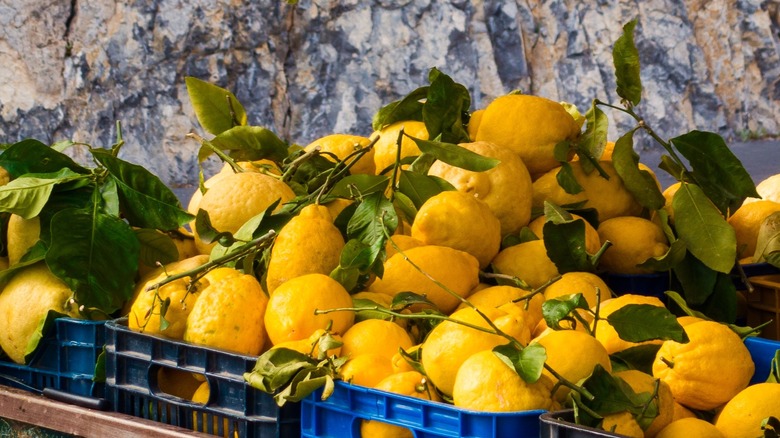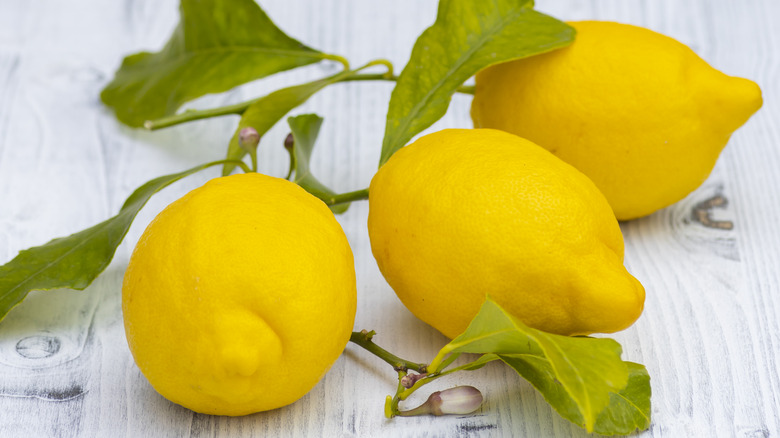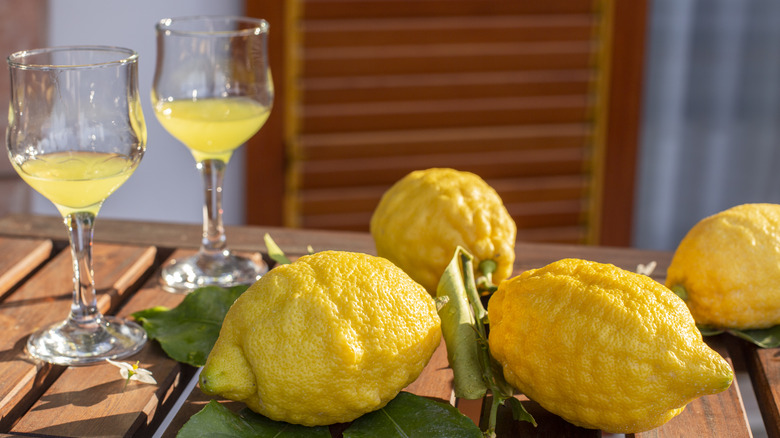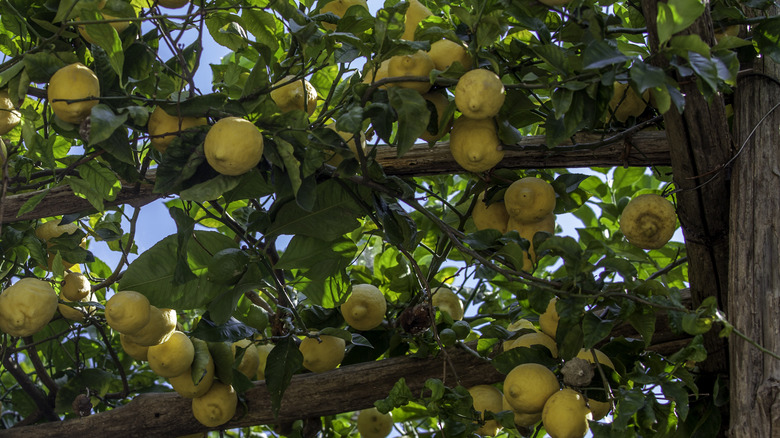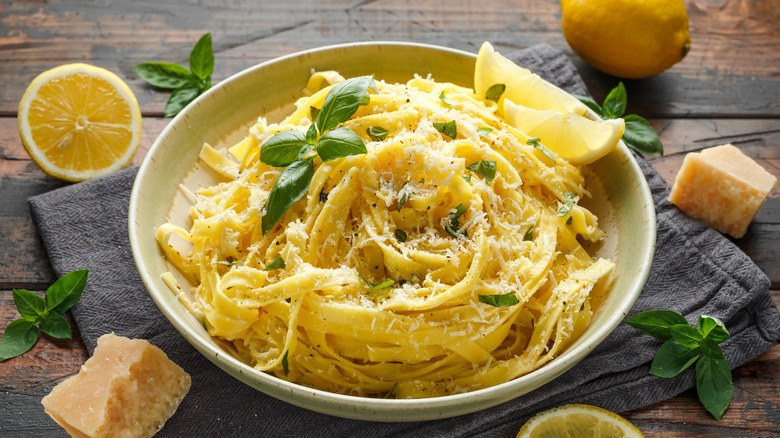What Makes Italy's Amalfi Lemons Unique
The Amalfi Coast is nothing short of whimsical. Between the array of colorful seaside villages, terraced vineyards, charmingly narrow streets, and sparkling beaches, Italy's southwestern shore is beyond picturesque. However, the most awe-inspiring element of the Amalfi Coast is that no matter where you venture, a lingering scent of citrus fills the air — a perfume owed to none other than the sfusato Amalfitano.
Located along the Sorrentine Peninsula of the Campania region, the Amalfi Coast is not just a UNESCO World Heritage Site, but it's also home to endless cliffside lemon groves. Despite the fact that the Fondazione Slow Food lists the ovale di Sorrento, Maiori, and Procida as some of the most prized cultivars, it's the sfusato d'Amalfi that reigns supreme. With a number of captivating and one-of-a-kind qualities, the sfusato also has a rich historical link to the coast's livelihood and culture.
Whether you know it as the sfusato Amalfitano or Limone Costa d'Amalfi, this is one pleasantly juicy lemon that's (almost) worth booking a trip to Italy to try!
A characteristically different sort of citrus
Derived from the more acidic Femminello cultivar, the Fondazione Slow Food explains that the sfusato Amalfitano is thought to date back to the days of the Roman Empire — in fact, images of lemons are still depicted on the ruins of villa mosaics. But how exactly did the lemons come to be?
During the 11th century, the small and sour lemons that were initially brought to Italy by Middle Eastern merchants were crossbred with local, bitter-tasting oranges, producing Amalfi lemons, according to Great Italian Chefs. With an elongated shape and tapered edges, Italy Segreta notes that it's no surprise that newly created lemons were named after the Italian word meaning "spindle."
Almost twice the size of a regular lemon, the sfusato is also significantly juicier, sweeter, and intensely aromatic. Picked from thorny branches, the Consorzio di Tutela Limone Costa d'Amalfi I.G.P. describes the lemon as having a bright and bumpy yellow rind that covers a super spongy pith. Hiding beneath that thick and pearly white pith is a tender, straw-colored pulp that bears almost zero seeds. As for what the Limone Costa d'Amalfi tastes like...
Sfusato Amalfitano flavor profile
Like a taste of liquid sunshine, the flavor of an Amalfi Coast lemon is something that begs to be tasted in order to best be understood. If you're only familiar with the mouth-puckeringly sour citrus that's stocked on grocery store shelves, think of Amalfi lemons almost like the (very) distant relative of a much mellower Meyer lemon.
Aside from being significantly larger and a tad more bulbous than standard supermarket citrus, sfusato lemons can be defined as ultra juicy and surprisingly sweet with a pith that's also fairly mild, rather than bitter — if you really wanted, you could eat the segments like that of an orange. But, regardless of its seemingly saccharine quality, the lemon still boasts an electric pop of acidity.
Since taste is also connected to smell, the wonderfully intense aroma of the sfusato can also work to enhance the citrus flavor. Boasting twice the amount of essential oils and terpenes when compared to other cultivars (via Fondazione Qualivita), the Limone Costa d'Amalfi I.G.P. has incredible complexity, which can influence the richness of flavor that's experienced.
Producing sfusato lemons
Terroir is a big part of why Amalfi lemons are so special — evidenced by the sfusato's I.G.P. designation. Though the area is almost constantly covered in sunshine, the coastal breeze delicately cools the mountainous fertile valleys, creating the ideal growing conditions for Amalfi lemons.
As lemons grow along the terraced orchards, Fondazione Qualivita explains that the citrus requires a significant amount of maintenance, especially when it comes to ensuring proper water drainage. In fact, Italia Segreta reports that after spring, plants aren't given any more water so as to keep aromas and flavors concentrated, causing fruit picked later in the harvest season (further inland) to be ever so slightly bolder.
Speaking of harvest, due to the less-than-ideal, rocky and sloped terrain, harvesting lemons is a genuine labor of love. Since operating machinery is nearly impossible, lemon growers must harvest the citrus by hand, the old-fashioned way. Flowering in May with harvest season running from February through October, Delicious Italy notes that once upon a time, men traditionally picked the lemons, whereas women instead carried the fruit down from the terraces.
Interestingly, while production remains a key part of Amlfitana culture, Fondazione Slow Food warns cultivation of the sfusato is at risk due to factors like a slowly decreasing number of qualified workers, high production costs coupled with low market value, and even competition from larger Sicilian plantations.
Fresh vs. processed products
Limoni d'Amalfi are usually available in their truest and most simple form: as fresh lemons. However, that isn't to say that these lemons aren't sometimes also transformed into other products.
Most often sfusato peels will be candied and used in baked confections as a means of preserving the lemon's vibrancy throughout the year (via Viva Viviana Varese). Much like other citrus fruits, Amalfi lemons can also be dried. According to Il fiore di cappero, sliced lemons can be dried and used as a garnish to adorn cocktails or as a zesty addition to tea. Giving dried peels a secondary life by pulverizing them is also a popular technique of Campanian chefs to infuse extra flavor.
While pickled lemons aren't common in Italian culinary preparations, lemons preserved as marmalades are frequently used to prepare confections. But, none of these "processed" versions of sfusato lemons display quite the same charm as a fresh sfusato. That said, how exactly can a freshly picked lemon be best put to use?
How to cook with the citrus
For sfusato purists, Fondazione Qualivita shares that these lemons can be simply cut into slices and enjoyed or even seasoned with a touch of olive oil, a bit of salt (or sugar), and mint leaves. However, there are endless ways to transform the citrus into sweet, savory, and drinkable delights — yes, we're alluding to limoncello, everyone's favorite post-meal digestivo.
Lemon juice can add a burst of acidity to salads and add freshness to fried or raw seafood. Likewise, a squeeze of citrus can even cut through the richness of meaty mains or enhance other flavors. As for the lemon rind, more than just a garnish for cocktails, Consorzio di Tutela Limone Costa d'Amalfi I.G.P. shares that the zest has the power to infuse flavor into oils and compound butters, plus add a bit of oomph to pasta sauces, risotto broths, and desserts like sorbet or the booze-soaked delizia al limone cake. But that's not all. Gambrinus reveals that the rind can even be added to espresso! Plus, let's not forget that the zest, along with pulpy pieces, can even make for a punchy citrus marmalade.
Since all parts of an Amalfi Coast lemon are edible, nothing should go to waste, not even the leaves. In fact, 177 Milk Street reports that young leaves can be battered and fried, whereas older foliage can be used to wrap cheese destined for smoking.
Purchasing these lemons might require a trip to Italy
Given that the sfusato d'Amalfi is a lemon with I.G.P. status (Protected Geographical Indication), which ensures that part of production is linked to the Amalfi Coast and crafted following traditional methods, the highest quality lemons can be purchased directly from local producers and market vendors along the coast. In addition to looking for firm, yellow rinds that are blemish-free and intoxicatingly fragrant, La Cucina Italiana also suggests shopping for lemons with green leaves still attached, as this is an indication that the lemons are freshly picked. As for the best time to purchase, the juiciest and sweetest-tasting lemons are available from late March through July.
In contrast, finding the citrus elsewhere can be a challenge. Supermarkets in Italy and Europe may sometimes stock the sfusato Amalfitano seasonally, whereas some online retailers will ship fresh lemons within Italy and other European countries, including the U.K. Across the pond, certain specialty retailers in the U.S. may also occasionally import the lemons. However, to be sure that you're getting the real thing, Eatsplorer recommends looking for I.G.P. labels on lemons and lemon byproducts like limoncello or confections.
Alternatively, some farmers in the U.S. (namely, California) are planting similar cultivars using the seeds from Amalfi lemons. However, given the different growing conditions, the fruit will likely vary from its authentic Italian cousin.
Nutritional benefits — and some cautionary advice
In addition to being a vibrant and delicious ingredient, lemons have long been believed to have nutritional and medicinal properties. In fact, Healthline shares that lemons (regardless of variety) have a rich concentration of vitamin C, along with beneficial plant compounds like hesperidin and diosmin, which can support heart health and lower cholesterol — the citric acid found in lemons can even prevent anemia as it helps the body to better absorb iron from plant sources.
According to studies done at Federico II University of Naples, the plump and vivacious Limone Costa d'Amalfi boasts a particularly high concentration of vitamin C, which is why the lemons were frequently ordered by decree to be brought onboard with sailors traveling long distances to prevent scurvy and anemia (via Guida di Positano)!
Although adding the lemons to your diet can be wise, there is a limit. Frequent consumption of any sort of lemon juice can damage tooth enamel and cause decay, in addition to triggering acid reflux. In moderation, however, consumption of the sweet Italian limone doesn't pose a significant risk.
